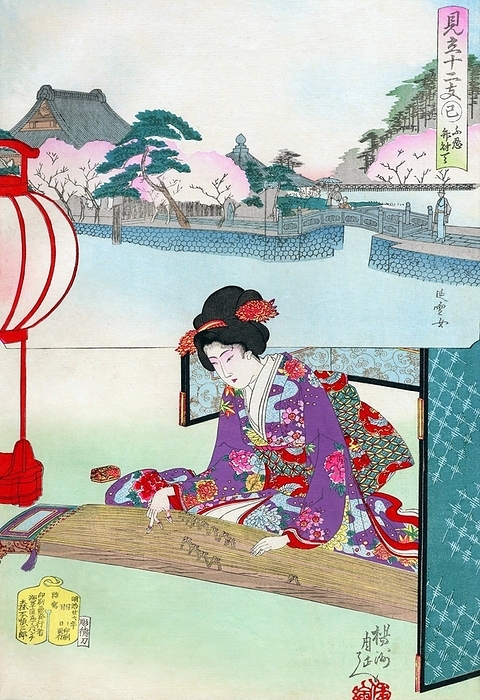
ED
Japan: A woman playing the koto at Shinobazu Pond, Ueno. Ukiyo-e woodblock print by (Toyohara) Yoshu Chikanobu (1838-1912)
A woman leans lightly forward to play a koto. While she appears to be inside, backed by a folding screen and seated near a paper lantern that glows softly, the inset shows blossoming cherry trees around Shinobazu Pond at Ueno, with its shrine to the Buddhist deity Benzaiten. inset shows blossoming cherry trees around Shinobazu Pond at Ueno, with its shrine to the Buddhist deity Benzaiten.
Toyohara Chikanobu (1838-1912), better known to his contemporaries as Yōshū Chikanobu, was a prolific woodblock artist of Japan's Meiji period. His works capture the transition from the age of the samurai to Meiji modernity.<br/><br/><br/>The work of Toyohara Chikanobu (1838-1912), better known to his contemporaries as Yōshū Chikanobu, was a prolific woodblock artist of Japan's Meiji period.
In 1875 (Meiji 8), he decided to try to make a living as an artist. He travelled to Tokyo. He found work as an artist for the Kaishin Shimbun. In his younger days, he had studied the Kanō school of painting; but his interest was drawn to ukiyo-e.<br/><br/>In 1875 (Meiji 8), he decided to try to make a living as an artist.
Like many ukiyo-e artists, Chikanobu turned his attention towards a great variety of subjects. As well as a number of the other artists of this period, he too portrayed kabuki actors in character, and is well-known for his impression. As well as a number of the other artists of this period, he too portrayed kabuki actors in character, and is well-known for his impressions of the mie (formal pose) of kabuki productions.<br/><br/><br/>These are the first two works of the series.
Chikanobu was known as a master of bijinga, images of beautiful women, and for illustrating changes in women's fashion, including both traditional and Western clothing. For example, in Chikanobu's images in Mirror of Ages (1897), the hair styles of the Tenmei era For example, in Chikanobu's images in Mirror of Ages (1897), the hair styles of the Tenmei era, 1781-1789 are distinguished from those of the Keio era, 1865-1867.
Details
ID
177779571
Collection
License type
Editorial
Photographer
Creation date
05-01-2022
Contact Aflo for all commercial uses.

More
Top Categories
